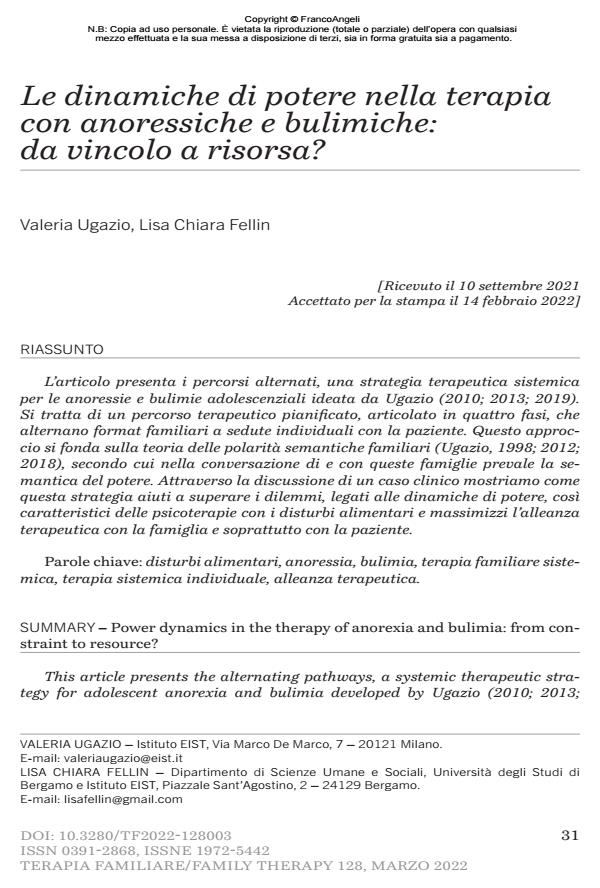Power dynamics in the therapy of anorexia and bulimia: from constraint to resource?
Journal title TERAPIA FAMILIARE
Author/s Valeria Ugazio, Lisa Chiara Fellin
Publishing Year 2022 Issue 2022/128
Language Italian Pages 24 P. 31-54 File size 664 KB
DOI 10.3280/TF2022-128003
DOI is like a bar code for intellectual property: to have more infomation
click here
Below, you can see the article first page
If you want to buy this article in PDF format, you can do it, following the instructions to buy download credits

FrancoAngeli is member of Publishers International Linking Association, Inc (PILA), a not-for-profit association which run the CrossRef service enabling links to and from online scholarly content.
This article presents the alternating pathways, a systemic therapeutic strategy for adolescent anorexia and bulimia developed by Ugazio (2010; 2013; 2019). It is a planned therapeutic path, articulated in four phases, which alternate family formats with individual sessions with the patient. This approach is based on the family semantic polarities theory (Ugazio, 1998; 2012; 2018), according to which the semantic of power prevails in the conversation of and with these families. Through the discussion of a clinical case, we illustrate how this strategy helps to overcome the dilemmas, related to the dynamics of power, so characteristic of psychotherapies with eating disorders and also maximizes the therapeutic alliance with the family and especially with the patient.
Keywords: Eating disorders, anorexia nervosa, bulimia nervosa, systemic family therapy individual, systmic therapy, therapeutic alliance.
- The Planned Alternating Pathways: a flexible protocol for working with anorexic and bulimic adolescents and their families Valeria Ugazio, Lisa Chiara Fellin, in Frontiers in Psychology 1603246/2025
DOI: 10.3389/fpsyg.2025.1603246 - Systemic relational therapy for eating disorders: analysis of family characteristics by means of the SCORE-15 Amanda Bellocci, Giulia Monnetti, Luigi Schepisi, Emanuele Basili, Gianmarco Manfrida, Daniela Tortorelli, in Frontiers in Child and Adolescent Psychiatry 1669051/2025
DOI: 10.3389/frcha.2025.1669051
Valeria Ugazio, Lisa Chiara Fellin, Le dinamiche di potere nella terapia con anoressiche e bulimiche: da vincolo a risorsa? in "TERAPIA FAMILIARE" 128/2022, pp 31-54, DOI: 10.3280/TF2022-128003